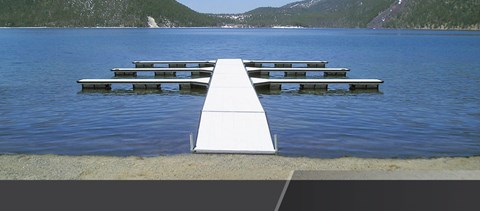Upgrade Your Beachfront With Long Lasting Floating Docks
Updating your beachfront with resilient floating docks can dramatically enhance both performance and appearances, offering a flexible option for numerous water activities. With a range of materials offered, consisting of low-maintenance alternatives and typical timber, selecting the right dock can match your individual design and fulfill practical needs.
Benefits of Floating Docks
Floating docks deal a wide variety of advantages that boost their charm for numerous maritime applications. Unlike standard fixed docks, floating docks rise and loss with the tide, making certain constant ease of access for watercrafts and watercraft no matter of environmental problems.
Furthermore, floating docks are easier to transfer and set up, providing versatility for seasonal or short-term usage. Their modular layout permits personalization to fit specific requirements, whether for exclusive marinas, domestic beachfronts, or industrial applications.
Furthermore, floating docks develop minimal disturbance to the water setting, preserving regional ecological communities and reducing the possibility of disintegration. They additionally provide improved security and security for users, as their buoyant nature uses an extra flexible surface area than rigid frameworks.
Moreover, floating docks can assist in a diverse variety of tasks, such as angling, swimming, and leisure boating, making them a beneficial possession for waterfront development. Their adaptability and usefulness make floating docks a preferred choice for a range of marine jobs.
Selecting the Right Materials
Choosing proper materials for floating docks is important to their longevity, performance, and overall effectiveness. When choosing products, consider factors such as ecological direct exposure, upkeep demands, and structural stability. Common materials consist of timber, plastic, light weight aluminum, and composite choices, each offering unique advantages and drawbacks.
Wood, while aesthetically pleasing, calls for normal maintenance to prevent rot and degeneration. Pressure-treated timber can improve toughness, yet it might still yield to water damage over time. Plastic floats, often made from high-density polyethylene, are immune to deterioration and call for marginal maintenance, making them an eye-catching option for low-maintenance applications.
Aluminum is an additional feasible choice, known for its strength and light-weight properties. It is immune to corrosion and can endure harsh climate problems, although it may be more costly than various other materials. Compound materials incorporate the very best attributes of wood and plastic, offering a low-maintenance and durable alternative that mimics the look of wood without the linked disadvantages.
Inevitably, the option of product must align with the planned use, ecological considerations, and budget restraints, making certain a useful and resilient floating dock that fulfills your particular needs.
Installment Process Introduction
The successful installment of a floating dock relies upon cautious planning and implementation, guaranteeing that it runs efficiently in its intended environment. The initial step involves evaluating website problems, consisting of water depth, shoreline functions, and dominating climate patterns, which will inform the dock style and anchoring system.
Adhering check it out to the website assessment, the next phase is to prepare the floating dock parts. This consists of assembling the framework, safeguarding drifts, and attaching any required equipment. It is crucial to ensure that all connections are waterproof and durable to hold up against aquatic problems.
As soon as the dock is constructed, the installation process commences with positioning the dock in the water. This can involve a crane or other lifting equipment, particularly for bigger structures. Correct placement is essential for functionality and safety.

Upkeep Tips for Durability
Normal maintenance is crucial for guaranteeing the long life and ideal efficiency of a floating dock. To accomplish this, start with routine examinations at the very least two times a year, concentrating on the stability of the dock's framework, including the flotation protection tools and linking equipment. Look for indications of damages, corrosion, or wear, and deal with any kind of issues immediately to stop additional damage.
Cleaning is one more essential aspect of maintenance. Eliminate particles, algae, and barnacles from the dock's surface to avoid unsafe problems and maintain aesthetic appeal. Utilize a mild detergent and a soft brush to stay clear of harming the dock's materials.
In addition, make certain that the dock is properly anchored and secured to have a peek at these guys endure seasonal modifications in water levels and weather. Inspect the anchoring system for security and make modifications as needed.
Enhancing Your Exterior Visual
To develop an aesthetically enticing outside area, integrating a floating dock can considerably improve the general aesthetic of your waterside home. Floating docks are not just useful yet can additionally work as a striking prime focus that matches the natural environments - floating dock company. Offered in various materials and layouts, these docks can be personalized to match your home's architectural style and landscape
The enhancement of ornamental aspects, such as integrated lights or elegant railings, further boosts the dock's aesthetic appeal. Consider making use of natural timber surfaces, which blend flawlessly with the atmosphere, or opting for modern-day products like light weight aluminum or composite decking that supply a smooth, contemporary appearance.
Strategically positioning planters or seating areas on or around the dock can develop inviting rooms that motivate relaxation and pleasure of waterfront sights. Additionally, including colors and appearances that harmonize with your landscape will certainly create a natural aesthetic throughout your outside location.

Final Thought

Upgrading your waterside with sturdy floating docks can dramatically enhance both performance and visual appeals, supplying a versatile service for different water tasks. Unlike conventional set docks, floating docks increase and autumn with the trend, ensuring constant access for watercrafts and watercraft regardless anonymous of environmental problems.Picking appropriate materials for floating docks is crucial to their long life, efficiency, and overall effectiveness.When the dock is set up, the installment procedure begins with positioning the dock in the water.In recap, floating docks offer many benefits, consisting of flexibility to water degree changes and a variety of material options.